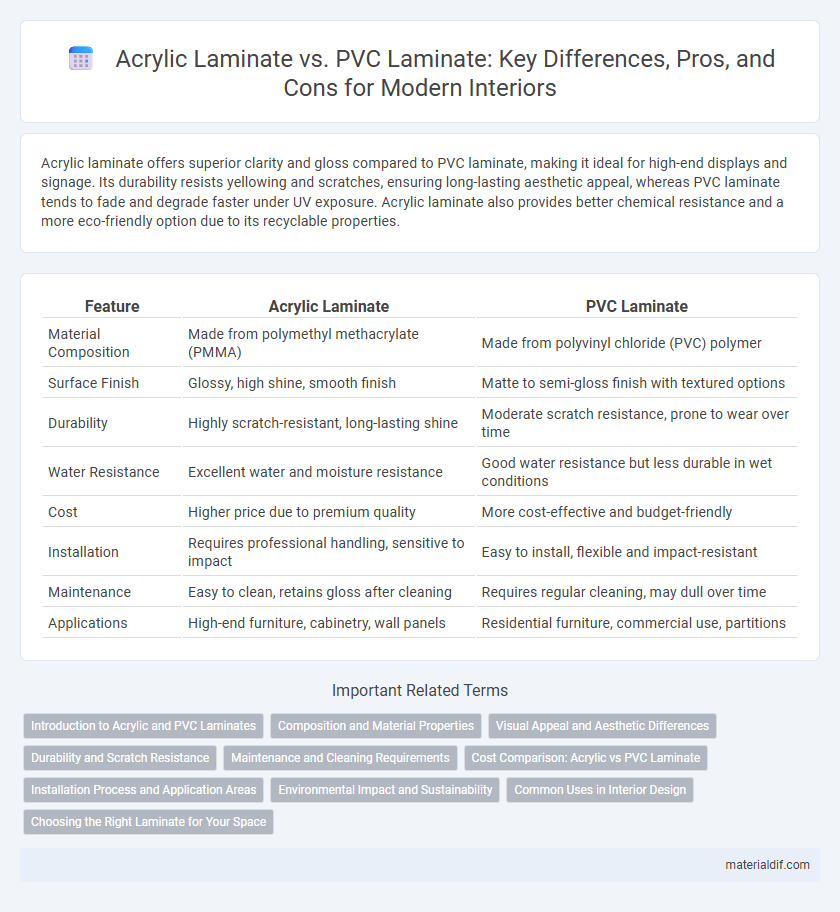Acrylic laminate offers superior clarity and gloss compared to PVC laminate, making it ideal for high-end displays and signage. Its durability resists yellowing and scratches, ensuring long-lasting aesthetic appeal, whereas PVC laminate tends to fade and degrade faster under UV exposure. Acrylic laminate also provides better chemical resistance and a more eco-friendly option due to its recyclable properties.
Table of Comparison
| Feature | Acrylic Laminate | PVC Laminate |
|---|---|---|
| Material Composition | Made from polymethyl methacrylate (PMMA) | Made from polyvinyl chloride (PVC) polymer |
| Surface Finish | Glossy, high shine, smooth finish | Matte to semi-gloss finish with textured options |
| Durability | Highly scratch-resistant, long-lasting shine | Moderate scratch resistance, prone to wear over time |
| Water Resistance | Excellent water and moisture resistance | Good water resistance but less durable in wet conditions |
| Cost | Higher price due to premium quality | More cost-effective and budget-friendly |
| Installation | Requires professional handling, sensitive to impact | Easy to install, flexible and impact-resistant |
| Maintenance | Easy to clean, retains gloss after cleaning | Requires regular cleaning, may dull over time |
| Applications | High-end furniture, cabinetry, wall panels | Residential furniture, commercial use, partitions |
Introduction to Acrylic and PVC Laminates
Acrylic laminate offers a high-gloss finish, exceptional durability, and resistance to scratches and UV rays, making it ideal for modern furniture and interior designs. PVC laminate, composed of polyvinyl chloride, provides cost-effective surface protection with good moisture resistance and ease of maintenance. Both materials serve as popular laminates, but acrylic is preferred for premium aesthetics and longevity, while PVC is commonly chosen for budget-friendly applications.
Composition and Material Properties
Acrylic laminate consists primarily of polymethyl methacrylate (PMMA), known for its high gloss, superior clarity, and excellent weather resistance, making it durable and UV-stable. PVC laminate, composed of polyvinyl chloride, offers flexibility, impact resistance, and affordability but lacks the premium shine and scratch resistance found in acrylic. The inherent hardness and chemical resistance of acrylic laminates provide a longer lifespan compared to the more porous and less durable PVC laminates.
Visual Appeal and Aesthetic Differences
Acrylic laminate offers a high-gloss finish with superior light reflection and vibrant color depth, creating a sleek and modern aesthetic ideal for luxury interiors. PVC laminate typically has a matte or semi-gloss texture, providing a more subdued appearance that mimics natural surfaces but lacks the brilliance of acrylic. The durability of acrylic laminate's surface resistance to scratches and chemicals enhances its long-lasting visual appeal compared to the more budget-friendly yet less glossy PVC option.
Durability and Scratch Resistance
Acrylic laminate offers superior durability and scratch resistance compared to PVC laminate, making it ideal for high-traffic areas and long-lasting surfaces. Its hard, glossy finish resists abrasions and maintains a polished look over time, whereas PVC laminate is softer and more prone to scratches and wear. The resilience of acrylic laminate ensures extended aesthetic appeal and functionality in demanding environments.
Maintenance and Cleaning Requirements
Acrylic laminate offers a smooth, non-porous surface that resists stains and fingerprints, making it easy to clean with just mild soap and water. PVC laminate requires more frequent cleaning and occasional use of specialized cleaners to prevent discoloration and maintain its appearance. Both materials benefit from avoiding abrasive scrubbing to preserve their finishes and extend durability.
Cost Comparison: Acrylic vs PVC Laminate
Acrylic laminate generally costs more than PVC laminate due to its premium finish and higher durability. PVC laminate offers a budget-friendly alternative with sufficient resistance for many applications but lacks the high-gloss sheen and scratch resistance of acrylic. Choosing between acrylic and PVC laminate depends on budget constraints and desired aesthetic quality.
Installation Process and Application Areas
Acrylic laminate offers a smooth, glossy finish and requires precise installation with professional tools to avoid surface damage, making it ideal for high-end cabinetry and furniture in residential and commercial spaces. PVC laminate provides easier installation with adhesive backing or adhesive sprays and is widely used for budget-friendly cabinetry, wall panels, and countertops due to its moisture resistance and flexibility. The choice between acrylic and PVC laminates depends on the project's durability needs, aesthetic preferences, and installation complexity.
Environmental Impact and Sustainability
Acrylic laminate offers superior environmental benefits compared to PVC laminate due to its recyclable properties and lower emission of volatile organic compounds (VOCs) during production. PVC laminate involves the use of polyvinyl chloride, which releases harmful chemicals like dioxins when manufactured or incinerated, posing long-term ecological risks. Opting for acrylic laminate supports sustainability by reducing toxic waste and enabling easier end-of-life recycling.
Common Uses in Interior Design
Acrylic laminate offers a high-gloss, durable finish often used for modern kitchen cabinets, wardrobes, and furniture surfaces requiring a sleek, reflective appearance. PVC laminate is favored for budget-friendly applications in interior design, such as wall panels, shelves, and low-traffic cabinetry, due to its water resistance and flexibility. Both materials provide versatile solutions, with acrylic laminate enhancing aesthetics and PVC laminate offering practical durability.
Choosing the Right Laminate for Your Space
Acrylic laminate offers a high-gloss finish and superior scratch resistance, making it ideal for modern kitchens and bathrooms where durability and aesthetics are essential. PVC laminate is more cost-effective, water-resistant, and flexible, suitable for budget-conscious projects or areas with high moisture exposure. Selecting the right laminate depends on balancing budget, design preferences, and environmental conditions to ensure long-lasting performance.
Acrylic Laminate vs PVC Laminate Infographic

 materialdif.com
materialdif.com